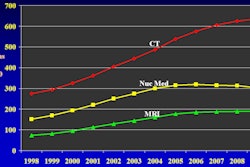Dear CT Insider,
As 2011 draws to a close, new studies of patients undergoing coronary CT angiography (CCTA) are revealing compelling information about coronary artery disease, treatment, and mortality. In this issue of the CT Insider, two analyses of CCTA in thousands of patients reveal new insights into patient triage and management that only CT can provide.
Revascularization or medical therapy? In an analysis of the Coronary CT Angiography Evaluation for Clinical Outcomes (CONFIRM) registry, investigators looked at CCTA results in more than 15,000 patients who were either revascularized or treated with statins following CCTA.
Over a 2.5-year follow-up period, patients who were revascularized after CT identified them as high risk had far fewer deaths than those referred for medical therapy alone. But revascularization conferred no benefit at all in patients whom CT identified as nonhigh risk. Get the rest of the story in this issue's Insider Exclusive.
A second analysis of CONFIRM data looked at more than 10,000 patients identified at CCTA as having nonobstructive coronary artery plaque (< 50% luminal stenosis): the kind of plaque whose presence probably wouldn't be revealed in a treadmill test, and the kind for which patients are rarely treated.
The study team found that patients with nonobstructive coronary artery disease who were treated with statins died in far fewer numbers than a similar group that was left untreated. Read about the study's implications for patients with "mild" atherosclerotic disease by clicking here.
A related feature article from the recent RSNA 2011 meeting in Chicago describes how imaging -- and CT, in particular -- have evolved to lead the diagnosis and management of atherosclerosis.
In lung cancer screening, researchers from Seoul, South Korea, have learned how to predict quite accurately which part-solid lung nodules will persist and present a higher risk for lung cancer, and which will almost certainly disappear over time. Find out how they did it here.
Radiation dose, another defining issue of 2011, is the subject of several articles in this issue of the Insider. At a recent symposium on tracking radiation exposure, experts weighed in on the issue of radiation dose tracking, an essential tool for protecting patients and clarifying the risks of exposure. You'll find the rest of the story here.
Another presentation from the symposium discusses new research in radiation risks that goes beyond atomic bomb survivor data, suggesting, in some cases, larger risks from smaller radiation exposures.
Fortunately, the American College of Radiology is on the case. Earlier this year, the organization launched a comprehensive dose-tracking system that automatically feeds high-quality exposure data from CT scans into an international repository. One thorny problem: different patient sizes, as you'll learn by clicking here.
We invite you to scroll though the links below for all the CT Digital Community news that fits in a teraflop. And we look forward to bringing you more in 2012.
With best wishes for a happy new year!




















